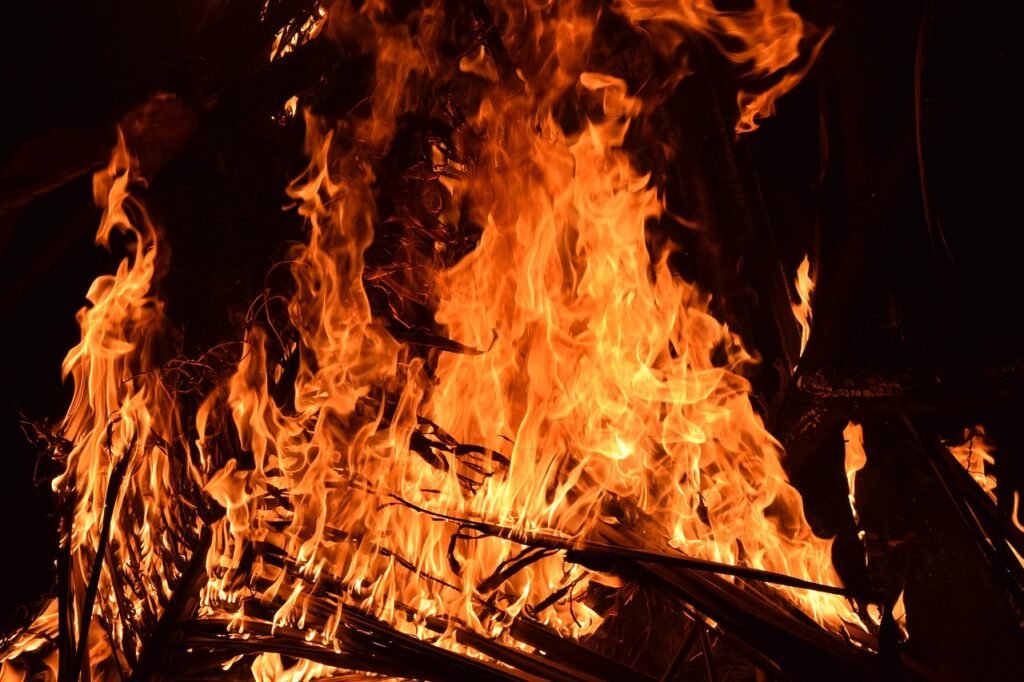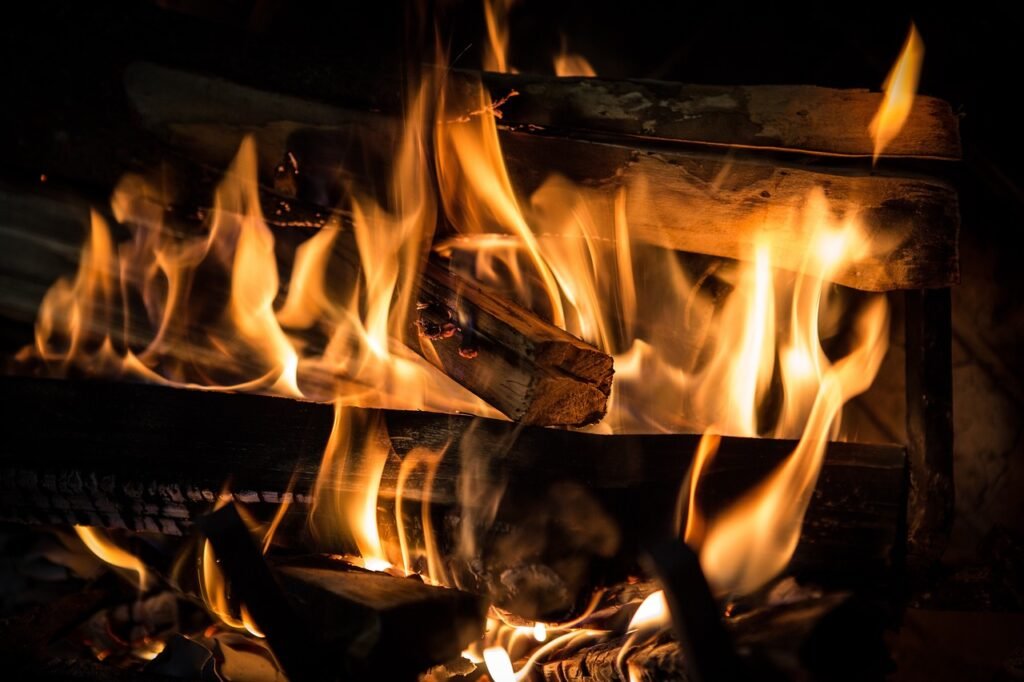In this article, we will explore how you can turn waste into warmth by maximizing energy efficiency in your fireplace. While fireplaces provide cozy ambiance and a comforting heat, they can also be major energy guzzlers. By implementing a few simple strategies, you can make your fireplace more eco-friendly, reduce energy consumption, and ultimately lower your utility bills. From choosing the right fuel to improving the insulation, we’ll show you how to create greener flames and make the most of your fireplace all winter long.

This image is property of pixabay.com.
Choosing the Right Fireplace
When it comes to choosing the right fireplace for your home, there are a few factors to consider. The first thing you should think about is the type of fireplace that best suits your needs. There are several options available, including wood-burning fireplaces, gas fireplaces, electric fireplaces, and ethanol fireplaces.
Wood-burning fireplaces are a traditional option that provides a cozy and authentic ambiance. Gas fireplaces offer convenience and can be easily controlled with a switch or remote control. Electric fireplaces are becoming increasingly popular due to their ease of installation and low maintenance. Ethanol fireplaces are a modern and eco-friendly choice, as they burn a renewable energy source.
Consider the size of your space, your heating needs, and your personal preferences when deciding on the type of fireplace that is right for you.
Evaluate the Energy Efficiency Ratings
To ensure that your fireplace is energy-efficient, it is important to evaluate its energy efficiency ratings. Look for fireplaces that have high ratings, as this indicates that they will produce more heat while using less fuel. You can find these ratings on the labels or product descriptions of the fireplace models you are considering.
By choosing an energy-efficient fireplace, you can not only reduce your carbon footprint but also save money on fuel costs in the long run.
Opt for a Fireplace Insert
A fireplace insert is a great way to increase the energy efficiency of your fireplace. Inserts are designed to fit into existing fireplaces and can greatly improve their performance. They are typically made of cast iron or steel and have insulated glass doors, which help to prevent heat loss and improve combustion efficiency.
Fireplace inserts also allow for better control of the airflow, resulting in a more efficient and cleaner burn. They can be used with various fuel types, including wood, gas, and pellets. Installing a fireplace insert can significantly reduce your energy consumption and increase the warmth and comfort of your home.
Maximizing Fuel Efficiency
To make your fireplace more fuel-efficient, there are a few tips to keep in mind. The type of firewood you use can have a significant impact on the efficiency of your fireplace. Always opt for seasoned firewood, as it has a lower moisture content and burns more efficiently. It is best to store your firewood in a dry and well-ventilated area for at least six months before use.
When choosing firewood, hardwood is generally a better option than softwood. Hardwoods such as oak, maple, and hickory burn slower and produce more heat compared to softwoods like pine or cedar. By burning hardwood, you can enjoy a longer-lasting and more efficient fire.
Another important factor in fuel efficiency is proper air circulation. Make sure the fireplace is properly ventilated to allow for a steady flow of oxygen. This will ensure a cleaner and more efficient burn. Using a grate or fireback can also help improve air circulation and promote a more efficient fire.

This image is property of pixabay.com.
Enhancing Insulation and Draft Control
To make your fireplace more energy-efficient, it is important to enhance insulation and draft control. One way to achieve this is by installing a tight-fitting fireplace door. This will prevent warm air from escaping through the chimney when the fireplace is not in use and help to reduce heat loss.
Using a chimney damper is another effective way to control drafts and improve insulation. The damper can be closed when the fireplace is not in use, preventing cold air from entering and warm air from escaping. This simple step can significantly reduce heat loss and increase energy efficiency.
In addition to these measures, it is important to seal any air leaks or cracks in and around the fireplace. This can be done using fireplace caulk or heat-resistant sealant. By sealing these gaps, you can prevent drafts and ensure that the warm air stays inside your home.
Insulating the chimney is also crucial in enhancing energy efficiency. A properly insulated chimney will prevent heat loss and keep your fireplace working at its best. Insulation materials such as ceramic wool or vermiculite can be used to line the chimney and improve its efficiency.
Improving Fireplace Design
Choosing the right design elements for your fireplace can significantly improve its energy efficiency. Opting for a high-efficiency fireplace grate is one way to achieve this. These grates are designed to maximize heat output by allowing more air to circulate around the fire. This results in a hotter and more efficient burn.
Consider a Rumford fireplace design, which is known for its superior heat reflection and high energy efficiency. Rumford fireplaces have a shallow and angled firebox, which promotes better combustion and reduces heat loss. This design is also aesthetically pleasing and can add a touch of elegance to your home.
Another option to improve fireplace efficiency is to install a heat exchanger. Heat exchangers capture and redistribute the heat that is produced by the fire, increasing overall energy efficiency. They can be installed in the fireplace or in the chimney and are a great way to maximize the heat output of your fireplace.
Using reflective firebacks is another design element that can enhance energy efficiency. Firebacks are placed against the back wall of the fireplace and reflect heat back into the room. This simple addition can increase the efficiency of your fireplace and make it more effective at heating your home.

This image is property of pixabay.com.
Maintaining an Efficient Fireplace
To ensure that your fireplace remains efficient, it is important to maintain it properly. Regular chimney cleaning is crucial to remove any build-up of creosote, which can reduce the efficiency of your fireplace and increase the risk of chimney fires. It is recommended to have your chimney cleaned at least once a year by a professional chimney sweep.
Inspecting and replacing gaskets is another important maintenance task. Gaskets create a seal between the fireplace door and the frame, preventing air leaks. Over time, gaskets can become worn or damaged, compromising their effectiveness. Regularly check the condition of the gaskets and replace them if necessary to maintain maximum energy efficiency.
Keeping the damper in good condition is also essential. The damper regulates the airflow in and out of the fireplace and helps to control the intensity of the fire. Ensure that the damper opens and closes smoothly and make any necessary repairs or replacements to maintain its efficiency.
Lastly, it is important to inspect the flue liner regularly. The flue liner provides a protective barrier between the fireplace and the chimney, preventing heat transfer and reducing the risk of chimney fires. Check for any signs of damage or deterioration and address them promptly to maintain the efficiency of your fireplace.
Alternative Fuel Options
If you are looking for more energy-efficient options for your fireplace, there are several alternatives to consider. Natural gas fireplaces are a popular choice as they produce clean and efficient heat. They can be easily controlled and provide consistent warmth without the need for firewood.
Electric fireplaces are another energy-efficient option. They are easy to install and require little maintenance. Electric fireplaces use electricity to generate heat and can be operated with a switch or remote control. They are a great choice for those who want the ambiance of a fireplace without the hassle of traditional fuel sources.
Ethanol fireplaces are a modern and eco-friendly alternative. They burn a renewable energy source and produce clean and efficient heat. Ethanol fireplaces do not require a chimney or venting, making them easy to install in any room. They are a sustainable choice for those who want to reduce their carbon footprint.
Pellet and wood-burning stoves are also worth considering. These stoves are highly efficient and can burn a variety of fuels, including wood pellets, corn, or biomass. They are a great option for those who want to heat their entire home or supplement their existing heating system with a more sustainable fuel source.
Eco-Friendly Fireplace Accessories
To further enhance the energy efficiency of your fireplace, consider using eco-friendly fireplace accessories. Eco-friendly fire starters, such as compressed sawdust or wax-based starters, are a greener alternative to traditional fire starters. They are made from renewable materials and produce fewer emissions when ignited.
Choosing sustainable materials for fireplace tools is another eco-friendly option. Look for tools made from recycled or renewable materials, such as bamboo or recycled steel. These materials are not only environmentally friendly but also durable and long-lasting.
Consider installing low-emission fireplace glass doors. These doors can help to reduce heat loss and prevent drafts while still allowing you to enjoy the view of the fire. They are designed to be energy-efficient and can significantly improve the overall performance of your fireplace.
By using eco-friendly fireplace accessories, you can further reduce your environmental impact and make your fireplace even more energy-efficient.
Supplementing with Solar Energy
For those who are looking to maximize energy efficiency and reduce their carbon footprint, supplementing your fireplace with solar energy is a great option. By installing solar panels on your property, you can generate your own electricity and power your fireplace using clean and renewable energy.
Solar panels convert sunlight into electricity, which can be used to power your home and appliances, including your fireplace. This allows you to reduce your dependence on traditional energy sources and lower your carbon emissions.
Additionally, solar energy can also be used for heating purposes. Solar heating systems, such as solar thermal collectors, can be installed to capture and store the sun’s heat. This heat can then be used to supplement your fireplace, providing additional warmth to your home.
To further maximize energy efficiency, consider installing solar-powered fireplace inserts. These inserts use solar energy to generate heat and can be a highly efficient and sustainable way to warm your home.
Monitoring and Reducing Carbon Monoxide Emissions
Ensuring the safety of your fireplace is just as important as maximizing its energy efficiency. Carbon monoxide (CO) is a colorless and odorless gas that is produced when fuel is burned. It can be extremely dangerous if not properly vented or if there are leaks in your fireplace system.
Installing carbon monoxide detectors is crucial to monitor and detect any potential CO emissions. These detectors will sound an alarm if dangerous levels of CO are detected, allowing you and your family to evacuate and seek fresh air immediately.
Proper ventilation is also important in reducing the risk of CO emissions. Ensure that your fireplace is properly vented to the outside and that there are no blockages or obstructions in the chimney or flue. Regularly clean and inspect your chimney to prevent the build-up of debris or creosote, both of which can contribute to CO emissions.
Checking for leaks and drafts is another important step in monitoring and reducing CO emissions. Inspect the seals and joints of your fireplace regularly to ensure that there are no leaks. Address any leaks promptly to prevent the escape of CO into your home.
By diligently monitoring and maintaining your fireplace, you can enjoy its warmth and ambiance while ensuring the safety of your household.
Considering Fireless Fireplace Alternatives
If you are concerned about the energy consumption and environmental impact of a traditional fireplace, there are several fireless fireplace alternatives to consider. These options provide the warmth and ambiance of a fireplace without the need for fuel or ventilation.
Heat-efficient electric fireplaces are a popular alternative. They use electricity to generate heat and can be operated with a switch or remote control. Electric fireplaces are easy to install, require little maintenance, and can be used in any room of your home.
Ventless ethanol fireplaces are another fireless alternative. These fireplaces burn a renewable energy source and produce clean and efficient heat. Since they do not require a chimney or venting, they can be installed anywhere in your home, providing flexibility in design and placement.
If you are looking for a low-maintenance and eco-friendly option, consider fireplace simulations. These simulations use LED lights and sound effects to mimic the appearance and crackling sounds of a real fire. They can be installed in existing fireplaces or as standalone units, providing a realistic and energy-efficient alternative.
By considering fireless fireplace alternatives, you can enjoy the warmth and ambiance of a fireplace while minimizing energy consumption and reducing your environmental impact.
In conclusion, maximizing the energy efficiency of your fireplace is not only beneficial for the environment but also for your wallet. By choosing the right fireplace, using fuel efficiently, enhancing insulation and draft control, improving fireplace design, and maintaining your fireplace properly, you can ensure that it operates at its highest efficiency. Additionally, considering alternative fuel options, utilizing eco-friendly accessories, supplementing with solar energy, and monitoring for carbon monoxide emissions will further enhance the energy efficiency of your fireplace. If a traditional fireplace is not suitable for your needs, there are fireless alternatives that can provide the same warmth and ambiance without the need for fuel or ventilation. By taking these steps, you can create a greener and cozier home while reducing your carbon footprint.




